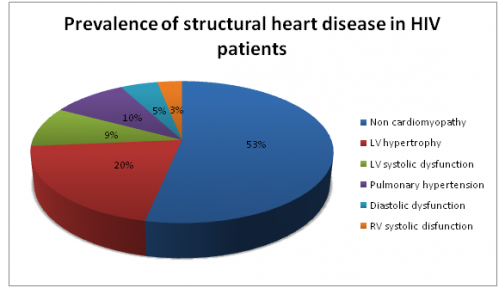HIV causes structural heart disease

HIV causes structural heart disease according to research presented at EuroEcho-Imaging 2013 by Dr Nieves Montoro from Madrid, Spain. The findings support the introduction of cardiovascular screening in all HIV patients, particularly those with a positive blood viral load.
EuroEcho-Imaging 2013 is the official annual meeting of the European Association of Cardiovascular Imaging (EACVI), a registered branch of the European Society of Cardiology (ESC). It takes place during 11-14 December in Istanbul, Turkey, at the Istanbul Lutfi Kırdar Convention & Exhibition Centre (ICEC).
Dr Montoro said: "It is well known that patients with HIV have a high incidence of structural heart disease (mainly diastolic dysfunction and pulmonary hypertension) as measured by echocardiography but the reason is not clear. We decided to conduct a study to evaluate whether the stage of HIV or the detectable blood viral load were related to the degree of heart disease."
This prospective cohort study included 65 HIV patients (63% male, average age 48 years) who had dyspnoea (shortness of breath) graded as >II on the NYHA scale.1 The stage of HIV was determined by measuring the CD4 count and their opportunistic diseases. Also, the viral blood load was determined. Patients had a transthoracic echocardiogram to assess whether they had structural heart disease (ventricular hypertrophy, systolic or diastolic dysfunction, or pulmonary hypertension). The following cardiovascular risk factors were assessed: hypertension, diabetes, smoking status, dyslipidemia and renal failure.
Nearly half of patients (47%) had some form of structural heart disease, mainly left ventricular hypertrophy, left ventricular dysfunction, pulmonary hypertension and signs of right ventricle failure (see figure). Patients with a positive blood viral load had a significantly higher incidence of structural heart disease than those with an undetectable load (75% vs 43%, p <0.04), independent of their cardiovascular risk profile or type of antiretroviral therapy.
Dr Montoro said: "We found that half of HIV patients with dyspnea had echocardiographic evidence of structural heart disease. Our most interesting finding was that patients with a positive blood viral load had a significantly higher incidence of structural heart disease. In fact, having a detectable blood viral load nearly doubled the prevalence of heart disease, suggesting that HIV itself might be an independent causal agent."
The amount of structural heart disease was not affected by whether or not the patient had AIDS, their gender, age, or presence of cardiovascular risk factors, although this is still a preliminary result and will have to be confirmed in further analysis.
Dr Montoro said: "Our study shows an association between the presence of the virus in the blood and cardiac disease. These findings open the door to the hypothesis that HIV is involved in the aetiology of cardiac damage. It is known that HIV can produce a pro-inflammatory response and this could involve the heart too. We are conducting further studies to test this idea."
She added: "One of the main objectives in HIV treatment is that blood virus levels are undetectable. When it is not achieved, the treatment is usually changed. Our findings show that having any detectable level of virus in the blood nearly doubles the risk of heart disease."
Dr Montoro continued: "Because of the high incidence of cardiac problems in our study (almost 50%) we think that all HIV patients with dyspnoea should undergo a transthoracic echocardiogram to check for structural heart disease. This is a non-invasive, cost-effective and accessible diagnostic test. Furthermore, patients with a positive blood viral load are at nearly twice the risk of structural heart disease and they should receive an echocardiogram whether they are symptomatic or not."
She concluded: "Detecting cardiac problems in HIV patients sooner using a simple diagnostic tool like echocardiography will enable us to treat them in the very early stage of the heart damage and improve their prognosis. Patients found to have a detectable blood viral load and/or structural heart disease should have closer follow up by a cardiologist and their HIV specialist doctor."











